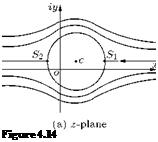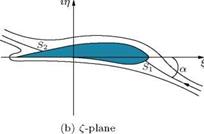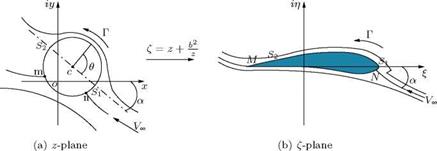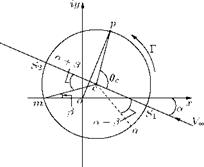Lift of Joukowski Aerofoil Section
Joukowski hypothesis directly relates the lift generated by a two-dimensional aerofoil to its incidence, as well as indicates the significance of the thickness to chord ratio and camber of the aerofoil in the lift generation.
We know that, applying the Joukowski transformation, f = z + b2/z, to an offset circle, as shown in Figure 4.14(a), a cambered aerofoil shape can be obtained, as illustrated in Figure 4.14(b).
If the remaining streamlines of the flow around the circle, in the physical plane, are also transformed, they will be distorted in the transformed plane to the shape of the streamlines around the aerofoil, as shown in Figure 4.14(b).
 |
 |
||
If the freestream flow approaches the circle at some angle of incidence a, as shown in Figure 4.15(a), but continue to transform about the original axes, the corresponding flow around the transformed aerofoil, in the f-plane, will be as shown in Figure 4.15(b).
 |
|
 |
|
Streamline pattern around (a) a circle in the z-plane, and (b) an aerofoil in the f-plane.
Figure 4.15 Streamline pattern of a freestream flow at some incidence a around (a) a circle in the z-plane, and (b) the corresponding flow around the transformed aerofoil in the f-plane.
|
Figure 4.16 Streamline pattern of a freestream flow and circulation around (a) a circle in the z-plane, and (b) the corresponding flow around the transformed aerofoil in the f-plane. |
This flow (regime) around the aerofoil is not sustained, although it is initiated every time an aerofoil starts moving from rest.
In practice, the generation of starting vortex shifts (dips) the rear stagnation point S2 to the trailing edge, that is to point M, shown in Figure 4.16(b). As the flow process develops, which takes place very quickly, the circulation around the aerofoil section is generated and the aerofoil experiences lift.
In the z-plane, the rear stagnation point S2 on the circle must have now been depressed to the corresponding point m to the trailing edge, as shown in Figure 4.16(a). In the transformed plane, the corresponding rear stagnation point S2 of the aerofoil is dipped to point M, as shown in Figure 4.16(b). This depression of the stagnation point enables the evaluation of the magnitude of the circulation.
At the same time, because of the circulation Г, the forward stagnation point S1 on the circle would have been depressed by a corresponding amount to point n. The angular displacement being (a + 0), as illustrated in Figure 4.17.
In Figure 4.17, by geometry, angle subtended by ZS2cm = ZS1 cn = (a + 0). The velocity at any point p on the circle, with 0c measured from the diameter S2cSj, given by Equation (2.51), is:
Г
Vc = 2V^ sin 0c + ,
2na
|
Figure 4.17 Depression of stagnation points. |
Therefore,
This is the lift coefficient of a two-dimensional aerofoil, in terms of thickness to chord ratio (t/c = 1.299e), percentage camber (100 0/2), and angle of incidence a. Though this relation for CL is compact, there are severe limitations for its use, because of the following reasons:
• It has been assumed throughout that the fluid is ideal, that is, incompressible and inviscid, that is, the viscous effects are neglected, although in the real flow process creating circulation Г, and hence lift L on an aerofoil, the viscosity (^) is important.
• One of the simplest transformation functions, namely the Joukowski transformation function, has been used in the analysis. Therefore, the results are applicable only to a particular family of aerofoils.
However, this result can be of use as a reference value. Differentiation of Equation (4.12), with respect to the incidence angle a, gives the ideal lift curve slope, a(xlI.
a^I — dC l/da
= 2n(1 + e) cos (a + 0).
For small values of eccentricity e, angle of incidence a and camber 0, this simplifies to:
This is the theoretical value of lift curve slope per radian of angle of attack, a. It is seen that, the lift curve slope is independent of the angle of attack.















